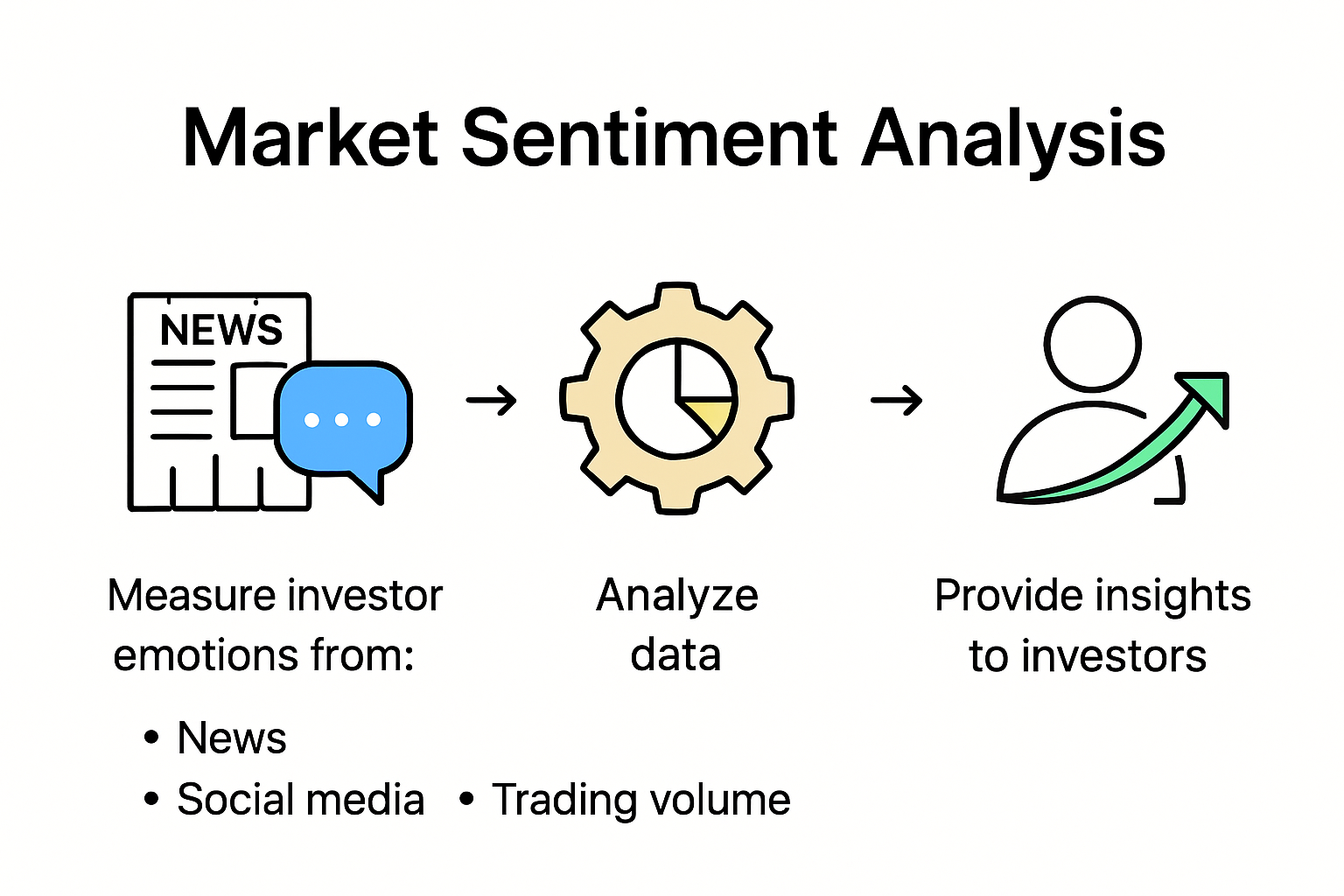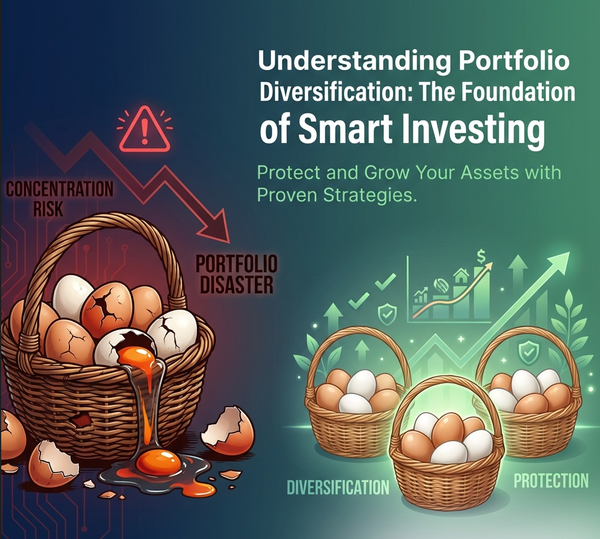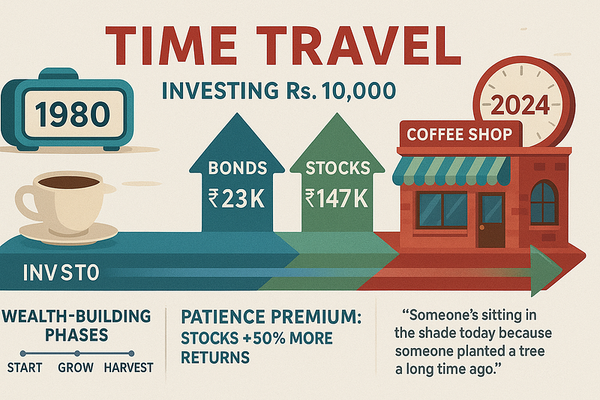Market Sentiment Analysis: Guide for Smarter Investing 2025

Investors are always searching for an edge in the markets, and market sentiment analysis has taken center stage as a way to understand what really moves prices. Most people focus on earnings, charts, or news headlines and overlook the invisible force of crowd emotion. But get this. A UC Berkeley study found that analyzing investor sentiment across 29.7 million stock price records can predict market shifts with remarkable accuracy. It turns out the collective mood of investors is not just noise, it is a real signal and if you know how to read it, you might spot the next big move before anyone else.
Table of Contents
- Understanding Market Sentiment Analysis Basics
- Popular Indicators For Market Sentiment
- How To Use Sentiment Analysis In Trading
- Top Tools And Resources For Investors
Quick Summary
| Takeaway | Explanation |
|---|---|
| Market sentiment reflects investor emotions. | Understanding the emotional landscape helps investors navigate market dynamics effectively. |
| Utilize advanced tools for sentiment analysis. | Tools like FinBERT and social media analysis can provide deeper market insights. |
| Integrate sentiment data into trading strategies. | Aligning sentiment shifts with trading signals can enhance decision-making. |
| Diversify sentiment indicators for robust analysis. | Combining multiple indicators yields a comprehensive view of market behaviors. |
| Stay updated on sentiment analysis technology. | Leveraging the latest advancements can improve investment strategies and market understanding. |
Understanding Market Sentiment Analysis Basics

Market sentiment analysis represents a powerful approach for investors to decode the complex emotional landscape of financial markets. Unlike traditional numerical analysis, this method explores the psychological undercurrents that drive investment decisions and market movements.
The Core Mechanics of Sentiment Analysis
Market sentiment represents the collective attitude of investors toward a particular financial market or security. Think of it as the market's emotional pulse. Investors and analysts use sophisticated techniques to measure this sentiment by analyzing multiple data sources including financial news, social media conversations, trading volumes, and economic indicators.
According to research from the UC Berkeley School of Information, sentiment analysis involves systematically processing vast amounts of textual data to extract nuanced insights about investor attitudes. Their comprehensive study examining 29.7 million stock price records revealed that sentiment signals can significantly predict market movements with remarkable accuracy.
Techniques for Measuring Market Sentiment
Sentiment analysis employs advanced natural language processing and machine learning algorithms to transform unstructured text into quantifiable emotional indicators. These techniques break down complex linguistic data into measurable components:
- Semantic Analysis: Evaluates the underlying meaning and emotional tone of financial texts
- Contextual Understanding: Identifies subtle nuances in language that traditional numerical analysis might miss
- Trend Identification: Tracks shifts in investor attitudes across different market segments
Sentiment analysis techniques go beyond simple positive or negative classifications. They capture intricate emotional gradients that reflect investor psychology. By processing news articles, social media posts, and financial reports, these methods provide a dynamic view of market sentiment.
The process involves several sophisticated steps. First, algorithms parse massive volumes of text. Then, they apply complex linguistic models to understand context, tone, and implied meaning. Advanced machine learning systems can now detect subtle emotional undertones that human analysts might overlook.
Investors leveraging market sentiment analysis gain a significant strategic advantage. Rather than relying solely on historical price data, they can now tap into the collective psychological state of the market. This approach transforms raw emotional data into actionable investment insights, helping traders make more informed decisions.
Understanding market sentiment is not about predicting exact stock prices but comprehending the broader emotional currents driving investor behavior. It provides a nuanced lens through which investors can interpret market dynamics, anticipate potential shifts, and develop more robust investment strategies.
As financial markets become increasingly complex and interconnected, market sentiment analysis emerges as a critical tool for modern investors. By bridging the gap between quantitative data and human psychology, this approach offers a more holistic understanding of market movements.
To clarify the main types of sentiment analysis techniques and what they reveal, here's a summary table for reference:
| Technique | Description | Insights Provided |
|---|---|---|
| Semantic Analysis | Evaluates meaning and emotional tone in financial texts | Detects positive/negative trends |
| Contextual Understanding | Identifies subtle language and context nuances | Reveals investor mindset and intent |
| Trend Identification | Tracks shifts in overall attitudes across market segments | Spots emerging sentiment movements |
Popular Indicators for Market Sentiment
Market sentiment indicators provide investors with crucial insights into the collective psychological state of financial markets. These tools transform complex emotional data into actionable investment intelligence, helping traders make more informed decisions.
Social Media and Digital Sentiment Indicators
Social media platforms have emerged as powerful sources of real-time market sentiment. Research by Johan Bollen demonstrated that daily Twitter mood tracking can significantly predict stock market movements. Investors now leverage advanced algorithms to analyze social media conversations, extracting nuanced insights about investor attitudes.
Key digital sentiment indicators include:
- Social Media Volume: Tracking the frequency and intensity of discussions about specific stocks or market sectors
- Emotional Tone Analysis: Measuring the positive or negative sentiment in online financial discussions
- Viral Content Tracking: Identifying trending financial topics that might influence market perceptions

Advanced Sentiment Measurement Tools
Financial researchers have developed sophisticated indicators to quantify market sentiment with greater precision. The International Review of Financial Analysis introduced a new investor sentiment index (NISI) that provides superior predictive power for stock market volatility.
Critical sentiment measurement tools include:
- Fear and Greed Index: Measures investor emotions across different market conditions
- Put/Call Ratio: Indicates investor sentiment by comparing put and call options trading volumes
- Volatility Index (VIX): Tracks market uncertainty and potential future price fluctuations
Research from Frontiers in Artificial Intelligence highlights an important nuance: negative news tends to have a more significant impact on market sentiment than positive news. This asymmetry provides investors with critical insights into potential market reactions.
The most effective market sentiment analysis combines multiple indicators. Investors should not rely on a single metric but instead create a comprehensive view by integrating various sentiment signals. This holistic approach allows for more robust investment strategies that account for the complex emotional dynamics of financial markets.
Technology continues to revolutionize sentiment analysis. Machine learning algorithms now process vast amounts of data from news articles, social media, financial reports, and economic indicators. These advanced systems can detect subtle emotional undertones that traditional analysis might miss, providing investors with a more sophisticated understanding of market psychology.
As financial markets become increasingly complex, sentiment indicators serve as critical tools for navigating uncertainty. They offer a unique perspective that goes beyond traditional numerical analysis, helping investors understand the human factors driving market movements. By leveraging these advanced indicators, traders can develop more nuanced and adaptive investment strategies.
Below is a comparison table of popular market sentiment indicators and their key attributes to help clarify their distinct roles:
| Indicator | Main Data Source | What It Measures | Notable Insight |
|---|---|---|---|
| Fear and Greed Index | Market data, sentiment polls | Overall investor emotions under market conditions | Signs of fear or euphoria |
| Put/Call Ratio | Options trading volumes | Ratio of puts to calls traded | Anticipates bearish/bullish |
| Volatility Index (VIX) | Options market | Market's expectation of future volatility | Gauges uncertainty/risk |
| Social Media Volume | Social platforms | Frequency of stock/sector mentions | Measures crowd attention |
| NISI (Investor Sentiment) | Multiple financial/news data | Overall market sentiment index | Predicts volatility |
How to Use Sentiment Analysis in Trading
Sentiment analysis has transformed trading strategies by providing investors with deeper insights into market psychology. Unlike traditional analytical methods, this approach allows traders to understand the emotional undercurrents driving financial markets.
Integrating Sentiment Data into Trading Strategies
Research from CUNY Graduate Center demonstrates that incorporating sentiment analysis can significantly enhance trading performance. By systematically analyzing financial news and social media conversations, traders can develop more nuanced investment approaches.
Key strategies for implementing sentiment analysis include:
- Trend Confirmation: Use sentiment indicators to validate or challenge existing market trends
- Entry and Exit Signals: Leverage sentiment shifts as potential triggers for trading decisions
- Risk Management: Identify potential market sentiment reversals before they impact portfolio performance
Advanced Sentiment Analysis Techniques
A groundbreaking study using FinBERT reveals the power of deep learning models in financial sentiment prediction. These advanced techniques go beyond simple positive or negative classifications, offering sophisticated insights into market emotions.
Advanced traders can apply several sophisticated approaches:
- Machine Learning Models: Utilize neural networks to process complex sentiment data
- Natural Language Processing: Extract nuanced emotional signals from financial texts
- Real-Time Sentiment Tracking: Monitor instantaneous changes in market mood
Research in Frontiers in Artificial Intelligence highlights an important consideration: investor sentiment varies significantly across different investor profiles. This means traders must develop personalized approaches that account for individual market perspectives.
Successful sentiment analysis requires a multifaceted approach. Traders should combine multiple data sources, including financial news, social media discussions, economic reports, and expert analyses. By creating a comprehensive sentiment profile, investors can develop more robust trading strategies.
Technology continues to enhance sentiment analysis capabilities. Machine learning algorithms now process enormous volumes of data, detecting subtle emotional patterns that human analysts might miss. These advanced systems can identify complex sentiment relationships that traditional methods overlook.
However, sentiment analysis is not a guaranteed predictor of market movements. Smart traders use these insights as one component of a broader analytical strategy. They combine sentiment data with traditional financial analysis, technical indicators, and fundamental research to make well-rounded investment decisions.
The most effective traders view sentiment analysis as a complementary tool. It provides additional context and emotional intelligence to numerical data, helping investors understand the human factors driving market dynamics. By integrating these insights, traders can develop more adaptive and responsive investment approaches that account for the complex psychological landscape of financial markets.
Top Tools and Resources for Investors
Investors seeking to leverage market sentiment analysis have access to an expanding ecosystem of sophisticated digital tools and resources. These technologies transform complex emotional data into actionable investment intelligence, enabling more strategic decision-making.
Advanced Sentiment Analysis Platforms
FinBERT, a cutting-edge language model specifically designed for financial sentiment analysis, represents a breakthrough in understanding market psychology. This specialized artificial intelligence tool can process financial texts with unprecedented accuracy, extracting nuanced emotional signals that traditional analysis might overlook.
Key features of advanced sentiment analysis platforms include:
- Real-Time Data Processing: Instant analysis of financial news and social media
- Predictive Modeling: Machine learning algorithms that forecast potential market movements
- Multi-Source Integration: Combining data from diverse financial information streams
Open-Source and Professional Tools
Researchers have developed an impressive array of tools catering to different investor needs. The R package 'sentometrics' provides comprehensive tools for computing, aggregating, and predicting textual sentiment, making complex analysis accessible to both professional and individual investors.
Notable tools in the market sentiment analysis landscape include:
- Python Libraries: NLTK and SpaCy for natural language processing
- Specialized Platforms: Bloomberg Terminal and Refinitiv for professional investors
- Web-Based Services: StockTwits and TradingView for social sentiment tracking
UC Berkeley's School of Information developed an innovative website using deep learning and natural language processing to analyze real-time financial news. Their platform demonstrates how advanced technology can transform raw data into actionable investment recommendations.
Choosing the right tool depends on individual investor needs. Professional traders might require comprehensive platforms with advanced features, while individual investors could benefit from more user-friendly, cost-effective solutions. Many platforms offer free trials, allowing investors to test capabilities before committing.
Technology continues to revolutionize sentiment analysis. Machine learning algorithms now process massive datasets, detecting emotional patterns with increasing sophistication. These systems can identify complex sentiment relationships that human analysts might miss, providing a significant competitive advantage.
Investors should approach these tools as supplements to traditional research, not replacement for comprehensive financial analysis. The most effective strategy combines sentiment insights with fundamental research, technical analysis, and personal investment knowledge.
As artificial intelligence and machine learning continue evolving, sentiment analysis tools will become increasingly powerful. Investors who stay informed about these technological advances and learn to integrate them strategically will be better positioned to navigate the complex emotional landscape of financial markets.
Frequently Asked Questions
What is market sentiment analysis?
Market sentiment analysis is a method used by investors to understand the collective emotional attitudes of market participants towards specific securities or the market as a whole. It focuses on the psychological factors influencing market movements rather than just numerical data.
How can I measure market sentiment?
Market sentiment can be measured using various techniques, including semantic analysis of news articles and social media posts, tracking trading volumes, and utilizing sentiment indicators such as the Fear and Greed Index or Put/Call ratios.
Why is market sentiment important for investing?
Understanding market sentiment helps investors navigate market dynamics by revealing collective emotions that might not be apparent through traditional analysis. It can provide insights into potential market movements and inform better investment strategies.
Which tools are best for market sentiment analysis?
Some of the best tools for market sentiment analysis include advanced platforms like FinBERT, Bloomberg Terminal, and various open-source tools such as Python libraries for natural language processing. These tools help process and analyze large sets of emotional data from multiple sources.
Leverage AI-Powered Sentiment Insights for Smarter Investments
Are you finding it challenging to turn raw market sentiment data into real investment results? The article showed how investor emotions and real-time sentiment analysis can reveal market shifts faster than traditional methods. Yet, with so much information from news, social media, and advanced indicators, the real struggle is making sense of the data before an opportunity passes. StocksageAI was created for individual investors like you who want to transform complex signals into confident decisions. Our platform puts AI-driven tools at your fingertips, so you never miss a key market trend or emotional shift again.

Stay ahead of the market. Visit StocksageAI to access predictive analytics, real-time trend alerts, and expert-driven investment tools. Let your strategies grow smarter with the same AI methods discussed in our Market Sentiment Analysis: Guide for Smarter Investing 2025. Explore a new generation of actionable insights—start your smarter investing journey with us today.




